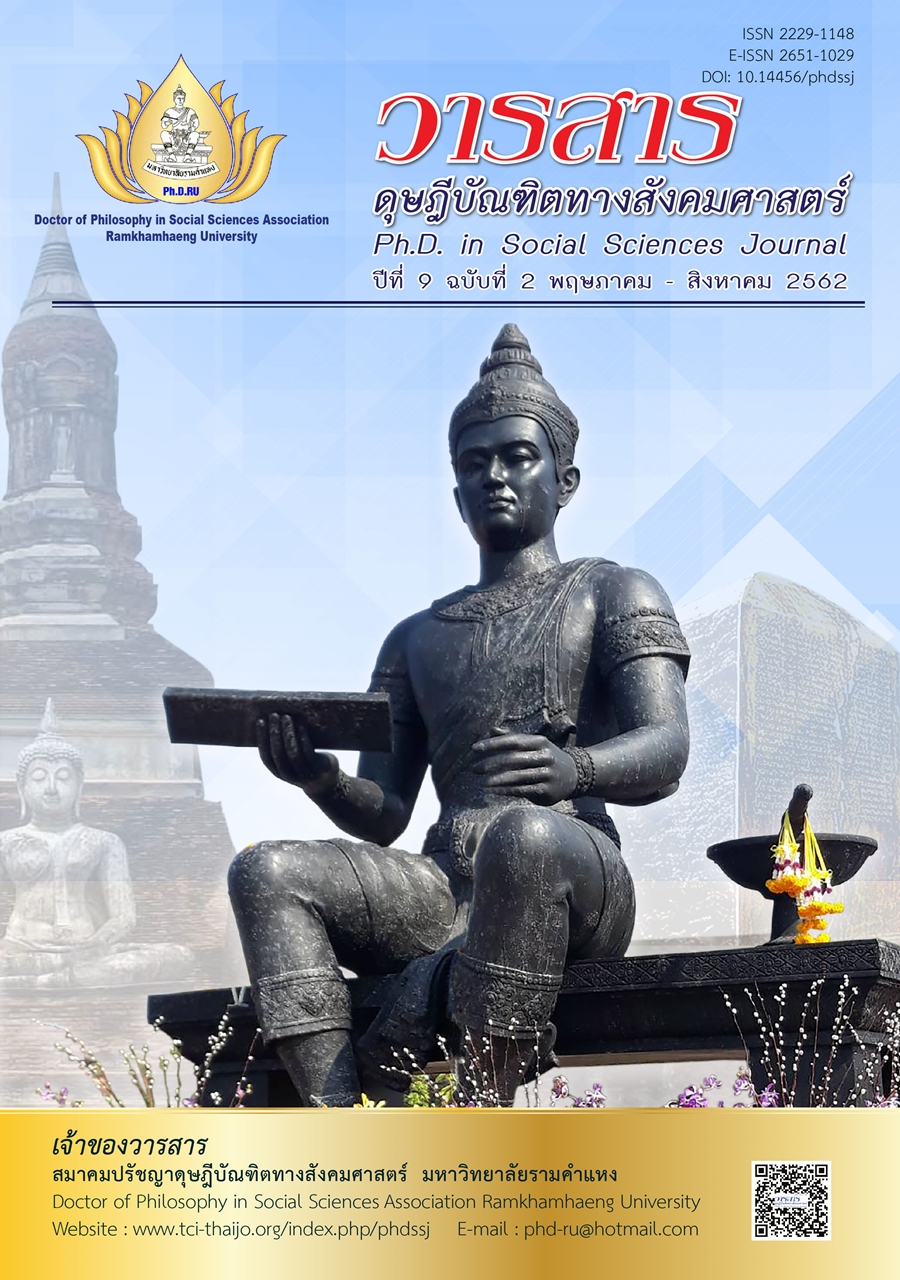อิทธิพลของผู้นำทีมต่อการรับรู้ผลงานทีม: กรณีศึกษาสโมสรฟุตบอลในระดับไทยพรีเมียร์ลีก
Main Article Content
บทคัดย่อ
การวิจัยครั้งนี้มีวัตถุประสงค์ (1) เพื่อศึกษาอิทธิพลของผู้นำทีมต่อปทัสถานทีม ต่อทีมงานที่ทรงประสิทธิภาพ และต่อการรับรู้ผลงานทีม (2) เพื่อศึกษาอิทธิพลของปทัสถานทีมต่อทีมงานที่ทรงประสิทธิภาพ และต่อการรับรู้ผลงานทีม (3) เพื่อศึกษาอิทธิพลของทีมงานที่ทรงประสิทธิภาพต่อการรับรู้ผลงานทีม ซึ่งการดำเนินการวิจัยครั้งนี้ใชก้ ารวิจัยเชิงคุณภาพและการวิจัยเชิงปริมาณควบคกูั่น โดยการสัมภาษณ์เชิงลึกผู้บริหารทีมในสโมสรฟุตบอลไทยระดับพรีเมียร์ลีกจำนวน 5 คน และตามด้วยเก็บข้อมูลด้วยแบบสอบถามจากสมาชิกทีมฟุตบอลจำนวน 550 ราย ในการวิเคราะห์ข้อมูลเพื่อตอบวัตถุประสงค์และทดสอบสมมุติฐานการวิจัยผู้วิจัยได้ใช้สถิติที่ใช้ คือ สถิติเชิงพรรณา, การวิเคราะห์ตัวแบบจำลองสมการโครงสร้าง และการวิเคราะห์เส้นทาง
ผลการวิจัย พบว่า ผู้นำทีมมีอิทธิพลทางบวกต่อปทัสถานทีม ต่อทีมงานที่ทรงประสิทธิภาพ และต่อการรับรู้ผลงานทีม ส่วนปทัสถานก็มีอิทธิพลทางบวกต่อทีมงานที่ทรงประสิทธิภาพ และต่อการรับรู้ผลงานทีม สำหรับตัวแปรคั่นกลางตัวสุดท้ายที่มีอิทธิพลทางบวกต่อการรับรู้ผลงานทีมคือทีมงานที่ทรงประสิทธิภาพ
การศึกษางานวิจัยครั้งนี้ ได้ข้อค้นพบที่สำคัญคือทีมงานที่ทรงประสิทธิภาพเป็นตัวแปรที่มีอิทธิพลสูงสุดในทางตรงต่อการรับรู้ผลงานทีมในสโมสรฟุตบอลไทยระดับพรีเมียร์ลีก ซึ่งผลจากการวิจัยครั้งนี้ถือว่าเป็นข้อค้นพบที่จะเป็นประโยชน์ต่อวงการฟุตบอลไทยในการนำไปประยุกต์ใช้เพื่อพัฒนาทีมฟุตบอลให้เป็นทีมที่ทรงประสิทธิภาพ ซึ่งจะส่งเสริมให้สโมสรฟุตบอลไทยมีผลงานที่โดดเด่นในโอกาสต่อไป
Article Details
บทความวิชาการ บทความวิจัย และบทวิจารณ์หนังสือในวารสารดุษฎีบัณฑิตทางสังคมศาสตร์ เป็นความคิดเห็นของผู้เขียน มิใช่ของคณะผู้จัดทำ และมิใช่ความรับผิดชอบของสมาคมปรัชญาดุษฎีบัณฑิตทางสังคมศาสตร์ มหาวิทยาลัยรามคำแหง (กรณีการทำวิจัยในมนุษย์ ผู้วิจัยต้องผ่านการอบรมจริยธรรมการวิจัยในมนุษย์ และนำหลักฐานมาแสดง)
เอกสารอ้างอิง
Bass, B. M. (1999). Two decades of research and development in transformational leadership. European Journal of Work and Organizational Psychology, 8(1), 9-32.
Bass, B. M., & Avolio, B. J. (2004). Multifactor leadership questionnaire: Manual leader form, rater, and scoring key for MLQ. Redwood City, CA: Mind Garden.
Bolman, L., G. & Deal, T. E. (1994). Looking for leadership: Another search party’s report. Educational Administration Quarterly, 30(1), 77-96.
Bateman, T. S., & Snell, S. A. (1999). Management: Building competitive advantage (4th ed.). Boston: McGraw-Hill.
Carron, A. V. (1988). Group dynamics in sport: Theoretical and practical issues. London: Spodym.
Gumusluoglu, L., & Ilsev, A. (2009). Transformational leadership, creativity, and organizational innovation. Journal of Business Research, 62(4), 461-473.
Hoy, W. K., & Miskel, C. G. (2005). Educational administration (6th ed.). New York: McGraw-Hill.
Stogdill, R. M. (1974). Handbook of leadership. London: Collier Macmillan.
Levi, D. (2011). Group dynamics for team (3rd ed.). New Bury Park, CA: Sage.
Luthans, F. (2011). Organizational behavior: An evidence-based approach (12th ed.). California: Crisp.
Mickan, S., & Rodger, S. (2000). The organisational context for teamwork: Comparing health care and business literature. Australian Health Review, 23(1), 179-192.
Mullen, B., & Copper, C. (1994). The relation between group cohesiveness and performance: An integration. Psychological Builletin, 115(2), 210-227.
Munroe, K., Estabrooks, P., Dennis, P., & Carron, A. (1999). A phenomenological analysis of group norms in sport teams. The Sport Psychologist, 13(2), 171-182.
Schermerhorn, J. R., Hunt, Osborn, R. N., & Uhl-Bien, M. (2012). Organizational behavior. New York: John Wiley & Sons.
Senge, P. M. (1990). The fifth discipline: The art and practice of learning organization. New York: Doubleday.
Vecchio, R. P. (1998). Organizational behavior. Chicago: Dryden Press.
Woodcock, M. (1989). Team development manual. London: Routledge.
Woodcock, M., & Francis, D. (1994). Teambuilding strategy (2nd ed.). Cambridge, UK: Cambridge University Press.


